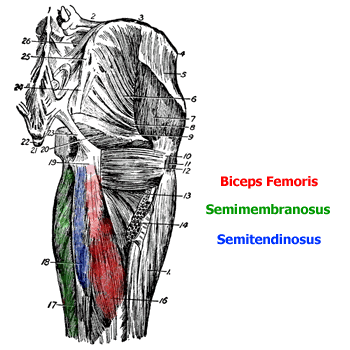Hamstring Injuries and Active Release Techniques (ART) Therapy

- Hamstring Strain Injuries (HSI) have increased by 4% annually in men’s pro European soccer since 2001 source
- the increase in HSI have occurred in training not during games
- eccentric strength does not return, even after symptoms abate source
- short biceps femoris fascicles and eccentric knee flexor weakness increase the risk of hamstring injury in elite football source
- most HSI are of the long head of the biceps femoris (BFlh) source
- flexibility may not return
What might cause this?
- after the HSI, pain causes the athlete to avoid strengthening the muscle at longer lengths
- this is called neuromuscular inhibition source
- the hamstring atrophies and the muscle fascicles shorten
- knee flexor torque joint angles change
- traditional rehab (leg curls) doesn’t address the shortened fascicles
- re-injury risk remains high
Active Release Techniques (ART)
The two big factors that are faced after an HSI mentioned above are NI and the shortened hamstring fascicles. ART has been proven to be very effective at increasing hamstring flexibility (see below). ART is a movement based soft tissue therapy. A patient shortens a muscle and then fully lengthens the muscle, while the provider maintains a manual tension on the muscle. The provider’s hands provide a fixed tension as the muscle slides under the contact. Does ART play a role in lengthening the shortened hamstring muscle fascicles after a HSI? Possibly
Focussed Structural Rehabilitation
Rather than using “functional” exercises, focus is put on the structural muscular composition of individual muscles. Eccentric hamstring exercises performed with the hamstring in a lengthened position are used to address the structural damage post HSI. Eccentric hamstring exercises have been shown to prevent first time and recurrent HSI (source). These exercises are a vital part of breaking the cycle of pain, atrophy, weakness, and re-injury of the HSI.
“Sarcomerogenesis, which is the process of adding the number of sarcomeres in series, gradually adapts the optimal muscle length to the zone in which it is operating. Not only eccentric training, but also regular strength training using exercises that are more challenging at lengthened ranges of motion can shift peak torque towards greater muscle lengths.” source
Why might speed not return post HSI?
“Eccentric training of any muscle increases the optimum angle at which torque is developed. Producing peak force at higher optimum joint angles means that the muscles are developing peak forces at longer muscle lengths.” source
The Nordic hamstring curl, glider, diver, slide board hamstring curl, and stiff legged deadlift all provide an eccentric contraction of the hamstring in a lengthened position. They will help build up the vital tolerance to eccentric loading, and resilience to eccentric muscle damage is important preseason and in season. Of course in season muscle soreness and sprinting load needs to be managed. To maintain fascicle length researchers recommend 8 reps per week.
What role does Neuromuscular Inhibition (NI) play?
Opar et al 2015 studied 99 Aussie footballers (82 controls) with a history of unilateral HSI. The eccentric strength of the hamstrings was measured at the start and the end of the preseason training utilizing the Nordic hamstring exercise (Nordbord). Those with a history of HSI displayed less improvement in eccentric hamstring strength across preseason training. The smaller improvements were not restricted to the previously injured limb as the contralateral limb also displayed similarly small improvements in eccentric strength.
The findings of this study may help explain why HSI recurrence rates are so high.
Does your team have one of these? They should!
The exercises:
Research on hamstring flexibility
Kage- Immediate effect of ART vs Mulligan Bent Leg Raise (MBLR) in subjects with hamstring tightness: RCT 2013
“A single session of ART is better as compared to MBLR technique to improve hamstring flexibility and range of motion.”
Shah, S + Kage, V.- Comparative Effectiveness of ART and Rolfing on hamstring tightness in normal subjects. RCT
“ART showed better improvement as compared to Rolfing in terms of Popliteal angle.”
George, JW- The effects of ART on hamstring flexibility 2006
“This study demonstrated that a single ART treatment increased hamstring flexibility in a group of healthy, active male participants.“
For more fitness, rehab, and wellness news, follow on Facebook and Twitter.
You may also like:
High Hamstring Strain: Best Low Compression Exercises
Best Glute Medius Exercises for Runners
Research Based Hamstring Therapy – FIT Institute
The New Age of Golf Training is Creating Stronger and More Athletic Golfers Than Ever Before – STACK
Performance Therapy: Greg Rutherford’s Story – Athletics Weekly
The ART of Active Release Techniques – Telegraph
How is ART different from Sports Massage – 220 Triathlon
Transform Performance – Vigour Magazine
Golf Performance Therapy – Titleist Performance Institute
Stronger Golf– Elbow Pain in Golfers: What To Do
